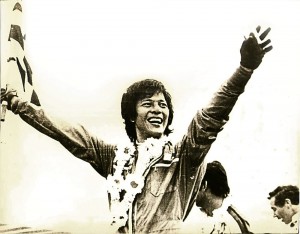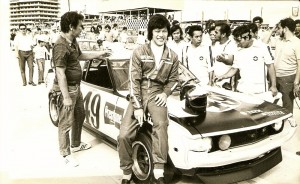Hi ho, Dante Silverio, away!

IN THE 1970s, this motorsports rockstar’s “guitar” was the Toyota Celica—and he made an F1 champ’s head shake.
If you could travel back in time, and bring your trusty iPod along, and if by chance you were anywhere in spitting distance of a racing podium in Greenhills sometime in 1972, your eyes would be drawn to a smiling, confident young man waving to the crowd. His left hand would be clutching a bottle of wine—a celebratory prop—no doubt, while his right hand would proudly hold up a checkered flag. The camera flashes, and the photo becomes an iconic snapshot of the 1972 Grand Prix. The man on the podium would be no other than Dante Silverio, who at age 32 perfectly embodies the song “Moves Like Jagger” playing on your iPod right at that very moment.
But more than just winning races, Dante belongs to a clan who may have single-handedly brought the Toyota brand—via Delta Motors Corp.—to the top of the race car podium in the Philippines.
Junep Ocampo’s book “Fast Lane (Motor Sports in the Philippines),” commissioned by the Automobile Association Philippines, generously sprinkles stories and pictures of the Silverios’ exploits on the racetrack. In one of its engaging pages, the book describes: “Dante’s uncle Ricardo Silverio was the one who brought the Toyota Marque to the Philippines in the ’60s, at a time when Filipinos were still very much averse to anything Japanese.”
Today, over 40 years after, the 72-year-old Dante gamely reveals what went on behind the scenes, and behind the wheels, of that racing era he so fondly highlighted with dust clouds.
Inquirer Motoring: Can you take us back to that moment in 1972 when you were celebrating with wine and a checkered flag? (The Greenhills Grand Prix was the third, while the first Philippine Grand Prix was held at the Cebu Reclamation Area in 1968, the second at Luneta in 1970)
Dante Silverio: 1972 was the start of the golden era in (Philippine) motorsports. Enthusiasm built up among the local guys. It became a major sports activity in the country.
It was an international motoring event participated in by Allan Moffat, Australia’s popular racing driver. (He was) driving the well-oiled Brian Hart engine, the hottest set-up at that time, and supposed to be the team to beat. We were using the factory racing car 1600 cc twin cam Toyota Celica, which eventually won the 1972 Philippine Greenhills Grand Prix.
IM: How many people were there?
DS: There were about 10,000 people watching around the track.
IM: Today’s youth can’t imagine Greenhills being a venue for a motorsport event.
DS: We were in infancy and the Greenhills track was going to be the “racetrack,” a kind of really very dangerous track.
IM: How did Greenhills look like back then? How did the track look like? Where was it actually laid out?
DS: It was a U-shaped track; great Formula One champion Jackie Stewart could only shake his head when we toured him around the track.
IM: Who among your family members were watching?
DS: It was a sort of family affair, not only for the Toyota team but as well as the other teams. The racing clubs were all cooperative to the effort, making enthusiastic representations. I was about 32 years old at that time.
IM: What Toyota car did you use during that race? Please cite the specs and changes made. Was it a production car?
DS: After an emotional appeal to Toyota Motor of Japan, they finally agreed to give us the factory racing car Toyota Celica, a twin cam 1600 cc with 165 hp.
IM: Was that the most coveted racing event in 1972? How big was the 1972 Greenhills Grand Prix? How long, how many years, was the Greenhills Grand Prix staged?
DS: We were lucky enough to use the Greenhills track for about five years. From thereon we moved to the BF Homes track in Parañaque.
Rock star of motorsports
IM: You were the rock star of Philippine motorsports in the ’70s and ’80s. Did you always feel that you would be destined for greatness?
DS: Not in my wildest imagination. My racing involvement was all struck by sheer luck and the love to be a part of it.
IM: In your opinion, did you have the most admirers/fans among your contemporary racers?
DS: My team was very dominant in that era, we were the winningest team, and it only follows that fans/admirers sided with us.
IM: How did your popularity affect your performance behind the wheel?
DS: It wasn’t easy, because you had the burden of keeping up with the trend, meaning it was continuous work and hard preparation for the team.
IM: How did your popularity affect the Toyota brand?
DS: I guess it made Toyota products number one in the Philippines.
IM: Speaking of Toyota, how did the motoring public view the brand at the time? Why did you put so much faith in the brand, while it was still largely race-untested?
DS: There wasn’t much trust in the product at the start. But the break came when an almost-bankrupt taxi company took the gamble and ended up successful. It became the turning point for the product.
IM: The book said: “Dante Silverio was almost always winning races during that decade, be it a grand prix on the Greenhills Ortigas track or a rally in the boondocks. He was always in the sports pages of newspapers because aside from being an excellent race car driver, he was also a champion basketball coach.”
DS: It was partly my dedication to strive to make my undertaking worthwhile.
IM: In your peak as a racer, did the sport occupy your entire day?
DS: It really did take a lot of my time. To be competitive, you have to have a certain dedication.
IM: Did you have to start karting first before racing with actual cars?
DS: Partly, during the Dodjie Laurel era, at the Batangas Kart track.
Living on the edge
IM: There’s a photo on page 155 (in the Silverio Collection) where it says, “Dante is still all smiles even after crashing his 2-liter Toyota Corolla during rally practice.” Why were you still smiling?
DS: After the accident and having gone through it unscathed, it only follows to knock on the hood of your car and thank God with a good smile that nothing serious happened.
IM: On Page 156 and 157, there’s a big picture of you and your Toyota Levin. The caption says “Dante Silverio is a sight to behold as he steers his Toyota Levin through the hills of Teresa Rizal.” The car roused up a big cloud of dust, adding to the magnificence of the image. Can you tell us more about it?
DS: The whole image on the picture represents the drama, suspense and thrill of rally driving.
IM: What were some of the real risks involved in racing and rallying at the time?
DS: A lot, unsafe race tracks, winding roads of the boondocks and crowd control.
IM: What safety measures were still not incorporated in the vehicles and the racing tracks?
DS: Cars were always equipped with safety requirements but most of the venues needed more attention to safety.
IM: Were there roll cages already back then?
DS: Always
IM: How about the quality of the helmets, the racing suits, crowd control, etc.?
DS: (We followed the) FIA standard always.
IM: What were you most afraid of when you were racing?
DS: The safety of the crowds.
Synonymous to Toyota
IM: The book says, “Dante Silverio’s connection with both car racing and basketball was all tied up with the brand his family represented from the ’60s to the ’80s—Toyota.” Please comment.
DS: Really? It’s true. Can’t help it because our business is Toyota.
IM: Why do you think your uncle brought in Toyota at the time? What did you think, then, of his decision to bring in a Japanese brand?
DS: It was a gamble.
IM: When the Toyota brand was brought in by the Silverios in the ’60s, were there already earlier plans that your family would also use it to race?
DS: None. Toyota didn’t have the capacity yet.
IM: What do you think of Toyota now, as a brand in general, and in its involvement in motorsports? What do you think of Toyota bringing in the 86 sports coupe?
DS: Toyota Motors has always been a lover of racing. In fact, they were deeply involved in Formula One Racing and WRC road rally. Unfortunately, they had to give way because of severe funding requirements. (Note: according to WRC.com dated April 5, 2012, Toyota has built a Global Race Engine and is being linked to a possible return to the FIA World Rally Championship powered by Nokia).
Dante Silverio now
IM: What are you busy with now? Your Facebook page says you are a painter and a flamenco dancer. When did you study/learn these things?
DS: These are my present love and passions. Life must go on with interest, otherwise, maybe life can be boring. Ha ha ha!


